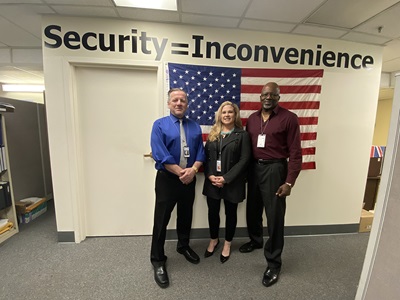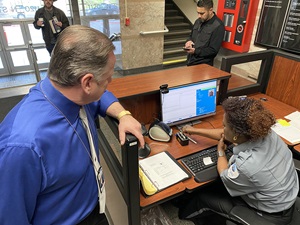Superior Accomplishment Award winners Mark Sproul, left, and Ervin Pridgen flank their supervisor, Allison Harris, in the Statewide Operation Services office at Caltrans Headquarters in downtown Sacramento. 
One inconvenient reality about our relentlessly tech-advancing world is that yesterday’s state-of-the-art software needs vital updates today and is irreparably outdated tomorrow.
Caltrans’ security staff had to confront that reality in a big-stakes, stressful way when it learned the identification-badge system that the department’s 20,000-plus employees use to gain entrance to buildings and office spaces was fast approaching obsolescence.
Microsoft in 2015 ended its mainstream tech support for Windows 7, a personal computer (PC) operating system that was soon to be supplanted by Windows 10. Microsoft’s “extended support” for Windows 7 would cease completely as of Jan. 14, 2020.
The bulk of Caltrans’ digital work is performed using Microsoft products, which is the case with the department’s Statewide Photo ID Badge System (PIBS). The PIBS software that allowed all Caltrans employees’ and visitors’ badges to function properly was called WebID. Although WebID was compatible with Windows 7, tests showed that it did not work smoothly with Windows 10.
So something different had to be fully implemented for PIBS by early this year. The idea that all our badges suddenly would work erratically or even not at all was unfathomable, perhaps even horrifying.
Ervin Pridgen and Mark Sproul of Caltrans’ Statewide Operations Security (SOS) team were tasked with finding a suitable replacement for WebID. Working with other Caltrans personnel and multiple partners, they oversaw a tremendous amount of research and analysis that convinced them an off-the-shelf product named BadgePass would be the best software to use under the Windows 10 operating system.

The BadgePass system saves time for Caltrans entrance-desk security guards by allowing them to run visitors' driver's licenses through a card-scanner.
Starting on a Wednesday evening in September 2018, 15 months ahead of the deadline, Caltrans’ deployment of BadgePass began. By noon the next day the new software had fully replaced WebID “with virtually no lapse in statewide security,” according to a narrative that accompanied Pridgen and Sproul receiving Superior Accomplishment Awards to honor their efficiency and hard work.
(Find recent Caltrans award recipients in the “Service Awards” tab at right, and find past award winners by navigating through past issues in “CT News Archive.”)
The SOS team supplemented BadgePass with a visitor management system that lets Caltrans security guards swipe any non-employee’s driver’s license and within 10 seconds generate a visitor’s pass. As anyone who is rushing to make a meeting or appointment can recognize, that new feature is not just a time-saver but also an anxiety-reducer.
“During the duration of this project,” Pridgen and Sproul’s commendation reads, “it took extraordinary effort from the SOS team to coordinate tasks between capture technologies, identity management, identity management consultants, database and middleware administration, server administration, IT security, network security, HQ desktop support; District 1-12 desktop support, business services management and their security coordinator staff in all districts to ensure a seamless transition from WebID to BadgePass.”
In addition to driver’s license scanners, the new equipment that security guards at Caltrans use with the BadgePass system include high-definition Canon cameras, tripods, barcode scanners, label printers and web cameras.

